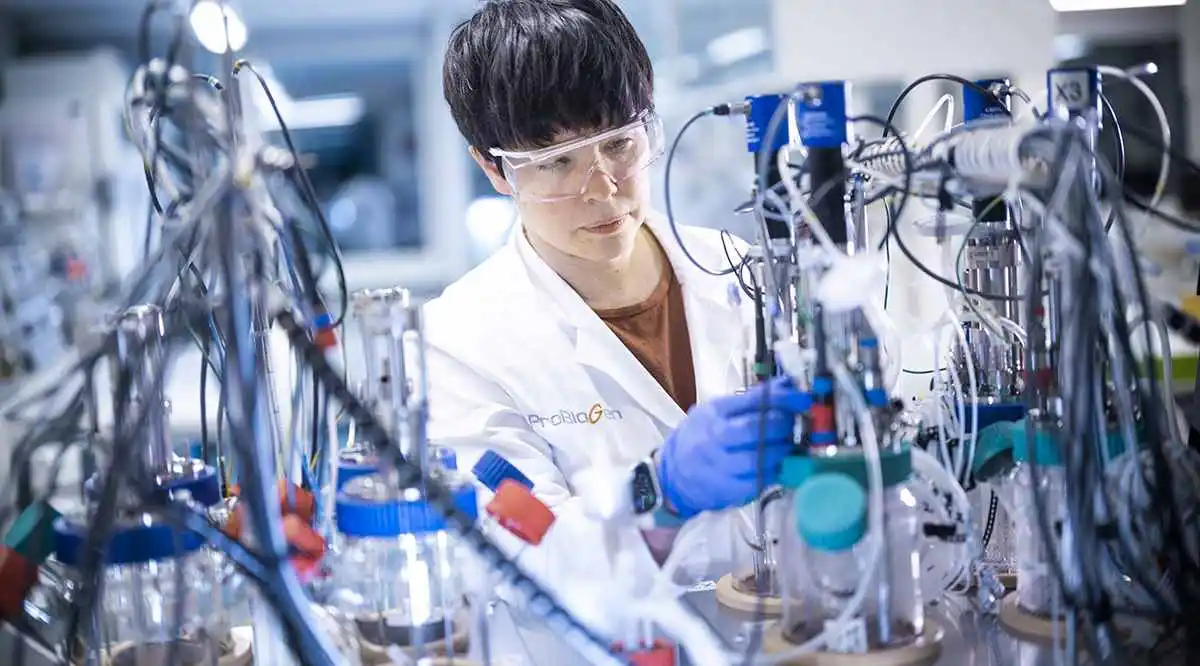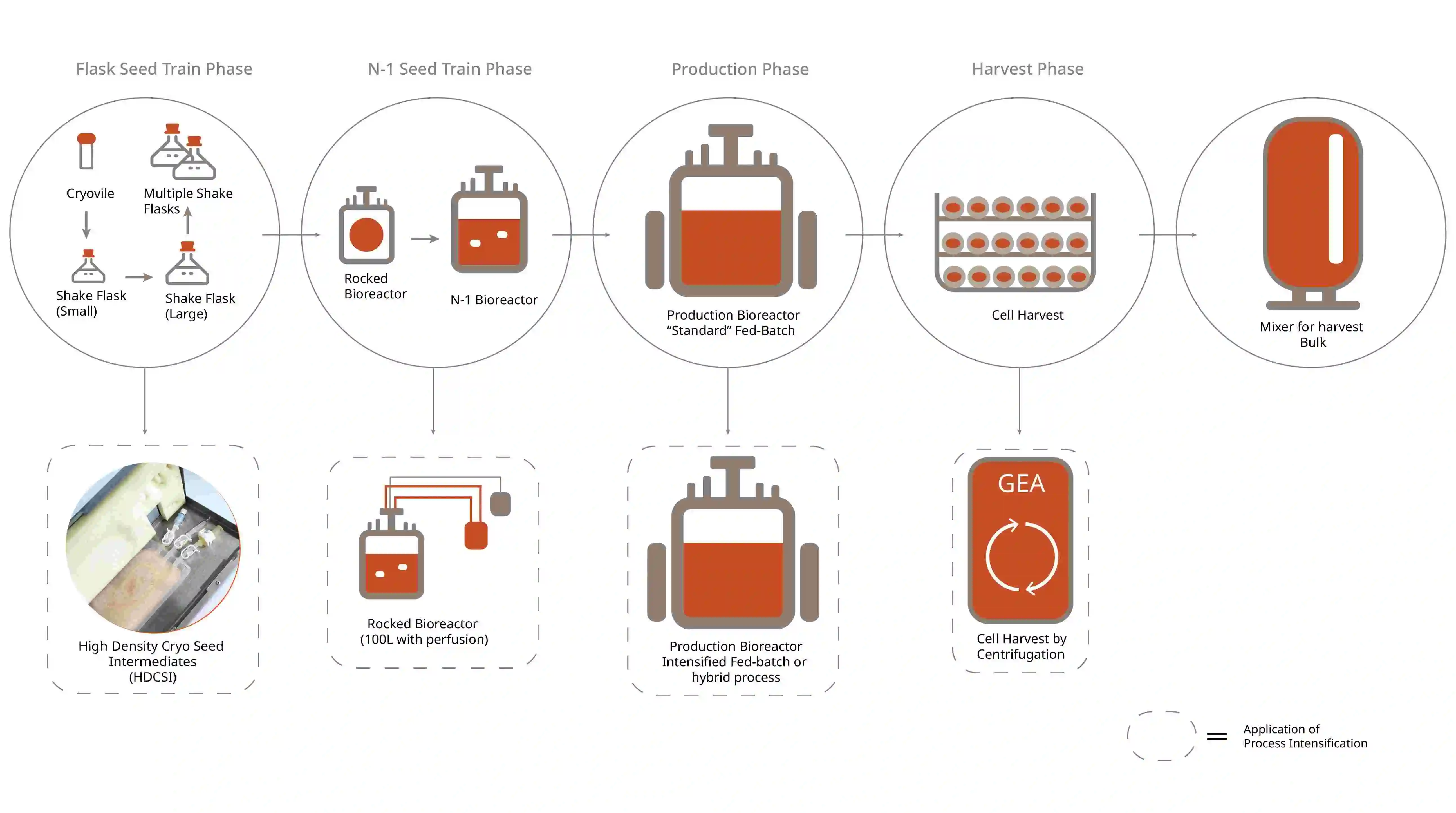Investing in Efficiency: Benefits of Process Intensification in Upstream Processing
May 23, 2024

Content
The Meaning of Process Intensification in Biotech & Impact in Upstream Processing
Methods for elevating product yield in USP
Accelerating Timelines: Streamlining Bioproduction
Overcoming Hurdles in Adopting Process Intensification
Higher Process Complexity vs. Accelerating Timelines
Challenges in Cell Separation by high cell densities
The Meaning of Process Intensification in Biotech & Impact in Upstream Processing
Process Intensification (PI) is more than just a buzzword; it is a strategic investment in the future of biotechnology. It expresses the drive for heightened productivity, accelerated timelines, cost-effectiveness and sustainability. This transformative approach transcends traditional methods, shaping the future of bioprocessing and offering many benefits to those who embrace it.
Applying Process Intensification in bioprocessing generally translates to achieving significant positive change in either cell growth/concentration, product yield, process step durations or bioreactor output. In upstream processing, every step from seed train to harvest should be considered in a PI-focused optimization in order to maximize production efficiency. Still, considerations should be made as Process Intensification also inherently increases the demands on equipment, the complexity of process design, execution and control. This can sometimes even be in conflict with or make it difficult to meaningfully shorten timelines. A balancing act that requires a great deal of experience and expert knowledge. At ProBioGen we have taken this challenge head on. Our extensive know-how and track record has enabled us to successfully integrate numerous new technologies and/or new processes, thereby ensure state-of-the art operations.

Methods for elevating product yield in USP
The classical fed-batch process is still the industry standard for upstream processing. However, with the traditional fed-batch approach certain titer limits are reached. To overcome this limitation and achieve an elevated product concentration, the biotech industry has explored innovative approaches. The intensified fed-batch process and the hybrid process are two options for intensification of the production process.
Intensified Fed-Batch Process with N-1 high density seed
In Intensified Fed-Batch (iFB), the process begins with a significantly higher cell concentration, typically 5 to 10 times greater compared to a standard fed-batch. This enables to skip the “unproductive” first days of a standard setup and dive into the “productive” phase faster. The outcome of an Intensified Fed-Batch can either be a gain in titer (i.e. more cells but same Qp and process duration) or a shorter production process (i.e. same titer in less time).
To reach such elevated inoculation concentrations, a N-1 high-density seed train is required, often relying on perfusion technology, as standard setups are not able to ensure this. If suitable single-use bioreactors and bags are available, the integration into the process scheme is usually possible without any major problems. This even offers the advantage that further intermediate seed bioreactor stages can be omitted if necessary, thus simplifying the seed train despite Process Intensification.
The advantages of the Intensified Fed-Batch approach are tangible. Not only does this method offer the potential for process enhancement (e.g. significant titer increase), but it also stands out for its practicality, as no perfusion technique is required at the large-scale production bioreactor stage. This simplifies the implementation of Intensified Fed-Batch, making it an attractive option for each biotech process. However, the response of each cell line and product quality attributes can significantly vary and must be examined from case to case.
Hybrid Process (hFB)
A more complex application of Process Intensification is the hybrid process (hFB), which setup combines elements of both fed-batch and perfusion processes in an attempt to harness the advantages of both worlds. Here, perfusion is used as a tool to enhance selected features of a fed-batch process without necessarily focusing on a continuous harvest. Depending on the process needs, this can occur either at the beginning of the process (i.e. enhance viable cell mass) or at the end (i.e. sustain viable cells). In any case, the goal would be to harvest the fed-batch (no increased liquid handling).
The potential of the hybrid process strategy has been shown on several occasions, whether for achieving higher yields or improving overall process robustness. However, this particular process type also significantly increases overall complexity and requires even higher demands on equipment as well as process strategy and control. Its implementation in an existing setup is therefore trivial compared to iFB. Furthermore, what applied to iFB, also can be seen in the present hFB case: The response of individual cell lines and the quality attributes of products can vary significantly and must be assessed on a case-by-case basis.
Accelerating Timelines: Streamlining Bioproduction
Another important aspect of Process Intensification is the reduction of development and manufacturing times for accelerated bioproduction. A major expectation of CDMO customers is a streamlined schedule from cell line development to the first released GMP drug product batch. Therefore, all process steps must be thoroughly reviewed and innovatively reconsidered with new concepts to provide competitive timelines and meet stringent deadlines.
High Density Cryo Seed Intermediates – a tailored seed train approach for accelerated Upstream Processing manufacturing
A great target for Process Intensification, in terms of accelerated timelines, is the seed train of an upstream process, during which cells are “only” expanded. This typically starts with a 2 mL cryovial, cultivation in shake flasks for about two weeks before entering the first seed bioreactor. This early USP phase is “unproductive”, time-consuming and incorporates many manual work steps. Therefore, a new seed train strategy which completely replaces the two-weeks early USP shake flask phase can be implemented: High Density Cryo Seed Intermediates (HDCSI). A HDCSI contains cells at high density (~ 1E8 cells/mL) which are produced in a perfusion bioreactor and are frozen in small-volume single-use bags (~ 100 mL). These intermediates are produced from a Master Cell Bank in a separate manufacturing step and are stored in nitrogen tanks. The cell amount is ~1000-fold higher in comparison to the standard approach and enables the start of the production process directly at the N-1 bioreactor stage, as a completely closed process, thus enhancing process reliability. Multiple batches can be started from one intermediate cryogenic bank, multiplying the benefits batch by batch.

Accelerated process development: how stable clone pools deliver valuable information for final process design
Another important consideration is to speed up process development. Besides integration of semi-automated parallel systems (e.g. Ambr®15) or Quality by Design tools (e.g. MVDA (Multi-Variate Data Analysis) or DoE (Design of Experiments) software), the traditional workflow can be condensed. In particular, stable clone pools can play an important role and help significantly reduce the timeline gap between cell line development (CLD) and GMP manufacturing by several weeks.
Traditionally, USP development is performed with a single-cell derived lead clone candidate. This ensures consistent cell culture performance and product quality up to manufacturing scale. However, it also means waiting upon completion of cell line development in order to initiate process development work. In order to accelerate timelines, USP development can be partially integrated within cell line development and already initiated during the stable clone pool phase. Using a well-established bioreactor platform process, initial data for the final process as well as Toxicology material batches can be generated at this point already. Once the lead clone is selected, USP development is finalized, also using the clone pool data. At all points the focus is set upon ensuring comparable output between pool and lead clone candidate (i.e. culture behaviours and product quality attributes).
Such a fast track approach is generally easily applicable to “simple” molecules (e.g. IgG1). Nevertheless, it will always remain a challenge to select the right clone in a fast track setup and deliver consistent quality. This challenge is even greater when developing complex molecules or if intensified processes are required in parallel. For this reason ProBioGen’s CLD, USP and DSP teams work in close collaboration in order to ensure a seamless workflows. Process safety at GMP level is and remains the most important parameter. Despite these challenges, a case to case study can be made and risks gauged.
Overcoming Hurdles in Adopting Process Intensification:
Higher Process Complexity vs. Accelerating Timelines
While process intensification holds the promise of optimizing bioprocessing in various ways, its adoption is not without obstacles.
An apparent contradiction lies in the increase in process complexity and the simultaneous acceleration of process timelines. This hurdle can only be overcome if all process steps and interfaces are optimized. The dynamic nature of the biotech industry demands a proactive approach to adapt and thrive. Fortunately, there are a plethora of cutting-edge techniques and strategies available to streamline both development and manufacturing processes.
By harnessing these innovative methods, there is an exciting opportunity to further reduce production timelines while simultaneously increasing production efficiency. Nevertheless, there are certain limitations. The development of processes for the production of extremely complex molecules and a maximum process and titer optimization cannot be combined with the shortest possible timeline, at least not without risks. It is much more important to define the appropriate setup for the specific product and the desired requirement to find a balance of process intensification.
Challenges in Cell Separation by high cell densities
As intensified production setups aim at achieving high cell densities, overall increased cell mass and consequently higher product titers, new challenges for each process step arise concerning process control, limitations and complexity. One major issue in the context of intensified bioproduction is the harvest procedure. During this step, a cell-free harvest bulk is generated, which contains the active biopharmaceutical ingredient (API) for subsequent downstream processing. Intensified processes and their increased cell mass often imply lower viabilities and higher turbidity levels, which put a strain on classical platform approaches (i.e. depth filtration). Filter capacities quickly reach their limits or large filter areas and flush-medium amounts are required which contradicts efforts to reduce costs and footprint. Furthermore, alternative methods such as classical stainless-steel separation centrifuges do not fit the concept of a CDMO multi-product facility where the use of single-use materials is preferred to avoid any risk of cross contamination or complex cleaning and decontamination.
It is therefore great to see that new devices capable of overcoming these existing limitations are constantly being developed. For example, an innovative single-use centrifuge was developed by GEA Westfalia Separator and stands out with its small-footprint, an easy operation and a high primary clarification capacity. This saves time, labor as well as costs and ensures a high process safety. The device was intensively tested at ProBioGen (see APPLICATION NOTE). The GEA kytero® single-use pharma separator ensures a high cell harvest step yield and process safety without any cell mass limitations and is therefore an excellent instrument for harvesting intensified processes.
In Conclusion:
Exploring the Future of Bioproduction Workflows & Customer Benefits through Process Intensification
Process intensification, exemplified by methods like HDCSI or iFB, emerge as a pivotal key to process optimization and titer increase. It is no longer a concept in the shadows but rather a defining characteristic of the state of the art and a reflection of the ever-increasing expectations of biotech and Contract Development and Manufacturing Organizations (CDMO) customers. In essence, process intensification offers tangible advantages to customers, from increased efficiency and reduced timelines to enhanced safety and a proactive approach to innovation. It is more than a buzzword; it is the way forward.
ProBioGen has established several process intensification strategies, which have the potential to significantly improve your process. For more information on how we can help you with you’re intensification needs please contact us.
